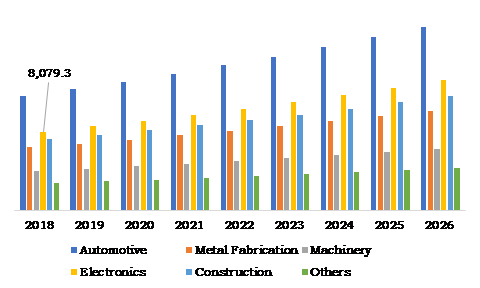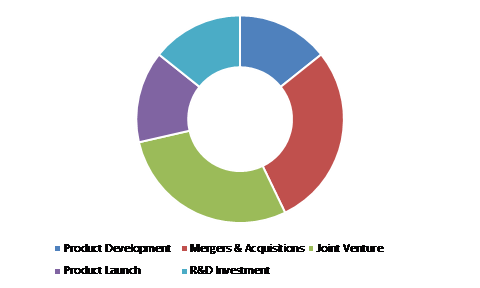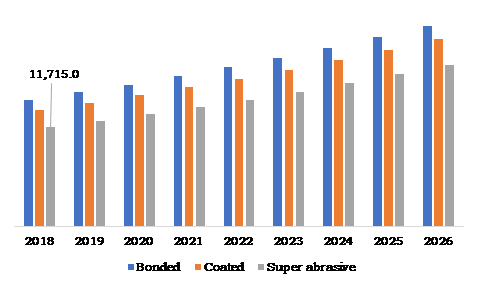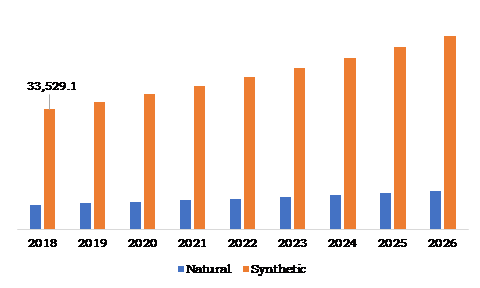Abrasive Market Report
RA00047
Abrasive Market, by Type (Super abrasive, Coated, Synthetic, Natural), End-Use (Automotive, Metal Fabrication, Machinery, Electronics, Construction, Others), Regional Analysis (North America, Europe, Asia-Pacific, LAMEA): Global Opportunity Analysis and Industry Forecast, 2019–2026
Update Available On-Demand
Abrasive Industry Overview 2026:
According to the abrasive market analysis by Research Dive, the abrasive market forecast will surpass $ 64,873.4 Million by 2026, increasing from $ 40,396.5 Million in 2018at a CAGR of 6.1%. Asia-Pacific Abrasive Market is expected to grow and is projected to account for $18,579.5 Million. Europe has dominated the global market and is projected to continue its dominance with a notable growth rate of CAGR of 5.8% over the forecast period.
Abrasives are substances that are used to clean or rough the surfaces of the minerals, or comminute the materials by abrasion and percussion. An abrasive is a type of very hard material and used in wide range of domestic, industrial and technological applications. Some common usages of abrasive materials include cutting, sharpening, sanding, grinding and polishing.
Driving Factors behind Growth of Abrasive Market
Rising product demand from automotive & machinery sectors is one of the key abrasive market trends
The market will witness growth, owing to the increase in product demand from automotive and machinery industries that use abrasive materials. The market is majorly driven by factors such as the upsurge in the use of abrasives materials in several sectors including metal fabrication, machine maintenance, and mechanical operations. The growth of such end use sectors with new advancements and developments in the economic circumstances are projected to drive the market growth in the coming years. Diamond abrasive materials are favored for the crushing and mending in the automotive sector to improve polishing time along with to improve the external surface and impart shiny appearance. The growth of the automotive industry is expected to directly enhance the abrasive materials demand in the forecasted time period.
Market Restraints:
Lack of raw material availability and the presence of price volatility are restraining the growth of abrasive market
However, in spite of advantages, demand for the abrasive material is estimated to be restricted by the price volatility of the raw materials. Also, there is a lack of availability in the raw materials. Both these factors are expected to limit the abrasives production, and thereby affect the market growth in a negative manner.
Market Opportunities for Abrasive Market:
Rapid industrialization in the emerging countries will provide significant investment opportunities for the growth of Abrasive Market
The rapid developments, coupled with the increasing industrialization activities in both developed and developing countries worldwide, will create ample investment opportunities in the abrasive market. Additionally, the increase in the number of vehicles, their maintenance and repairing have upsurge the abrasive materials use in the automotive industry.
Abrasive Market Segmentation, by Type
Super abrasive segment is predicted to be most lucrative till the end of 2026
Source: Research Dive Analysis
By type, the market is segmented into super abrasive, bonded abrasive and coated abrasive. The super abrasive type is projected to grow at a noteworthy rate, and accounted for $11,715.0 Million in 2018, and will surpass $19,089.9 Million in 2026. This growth is majorly attributed to the wide acceptance of super abrasive material in automotive, metal fabrication and machinery sectors. The bonded type held the dominant share in the global market in 2018 and is anticipated to account for $23,643.6 Million by 2026. The bonded type is available in several forms such as discs and wheels made of vitreous and rubber materials, due to this, the bonded type abrasives are preferred for majority of the applications.
Abrasive Market, by Material
The Synthetic material segment is predicted to be most lucrative till the end of 2026
Source: Research Dive Analysis
By material type, the market is further classified into synthetic and natural. Synthetic material type held for the largest market size and is accounted for $33,529.1 Million in 2018, and is projected to account for $54,092.0 Million by 2026, at a CAGR of 6.2% during the forecast period. This is majorly due to the extensive use of synthetic material type for fine grinding of metal alloys, adjusting dental enamel and polishing of noble metals. Silicon carbide and aluminum oxide are major contributors of synthetic material types in the abrasive market. Natural type abrasive material is projected to reach $10,781.5 Million and is increasing from $6,867.4 Million in 2018, this is due to its natural availability of natural types such as Arkansas stone, chalk, and corundum.
Abrasive Market, by End Use
Electronics end use segment is predicted to be most lucrative till the end of 2026

Source: Research Dive Analysis
By end use, electronics end use segment is accounted for $8,079.3 Million in 2018, is expected to experience a noteworthy rate of 6.5%, is projected to reach $13,371.2 Million by 2026. This is majorly attributed to substantial development in the industry to manufacture of optic electric parts and device components is expected to drive the abrasive material market in the machinery sector. The automotive end use segment held the major market share and is expected to reach $18,813.3 Million during the forecast period, is increasing from $11,715.0 Million in 2018. The rapid growth in the increasing adoption of abrasives in the automotive industry for renovating and maintaining the body of automobiles such as accessories, engine parts, and interiors are projected to drive the abrasive market size in the coming years.
Abrasive Market, by Region:
Asia-Pacific region will have enormous opportunities for the market investors to grow over the coming years
Asia-Pacific Abrasive Market Overview 2026:
The abrasive market for Asia-Pacific is expected to experience significant growth and is projected to account for $18,579.5 Million and is increasing from $11,311.0 Million in 2018. The swift growth in the industrialization in the fast-growing countries, which has additional produced rise in the number of manufacture facilities in Asia-Pacific countries is expected to create abundant opportunities in the growth of the abrasive market. China, Japan, and India are developing economies and major contributors in the Asia-Pacific.
Europe Abrasive Market Forecast 2026:
Europe has dominated the global market and is projected to continue its dominance with a notable growth rate over the forecast period. Along with Europe, the market for North America is expected notable market share and is expected to reach $15,855.1 Million by 2026, at a growth rate of 5.8%. This growth is attributed to the rapid growth in the expansion of automotive and machine manufacturing units in this region. The abrasive market in the U.S. is generation major revenue in the North America region.
Key participants in Global Abrasive Market:
Product development and joint ventures are the most common strategies followed by the market players

Source: Research Dive Analysis
The major players profiled in the global abrasive market include Saint-Gobain Abrasives, Bosch, Henkel, Carborundum Universal Ltd., Asahi Diamond Industrial Co. Ltd., DowDuPont, 3M, Tyrolit, Deerfos, Fujimi Incorporated and among others. The major players present in the global abrasives industry are focusing on the new product developments and mergers & acquisitions to increase their share in the global abrasive market in this competitive and fragmented market.
Scope of the Market Report:
| Aspect | Particulars |
| Historical Market Estimations | 2018-2019 |
| Base Year for Market Estimation | 2018 |
| Forecast timeline for Market Projection | 2019-2026 |
| Geographical Scope | North America, Europe, Asia-Pacific, LAMEA |
| Segmentation by Type
|
|
| Segmentation by Material
|
|
| Segmentation by End-use
|
|
| Key Countries covered | U.S., Canada, Germany, UK, Italy, Spain, Russia, Japan, China, India, South Korea, Australia, Brazil, Argentina, GCC and Saudi Arabia |
| Top Key Companies Profiled |
|
Source: Research Dive Analysis
Q1. What is abrasive industry?
A. The abrasives industry is collected of almost 400 companies involved in the several kinds of manufacturing includes bonded abrasive, coated abrasive, abrasive grain and their derivatives manufacturing.
Q2. What is the size of the Abrasive market?
A. The global Abrasive market size was over $40,396.5 Million in 2018, and is further anticipated to reach $64,873.4 Million by 2026.
Q3. Who are the leading companies in the Abrasive market?
A. Saint-Gobain Abrasives, Bosch, DowDuPont and Tyrolitare some of the key players in the global Abrasive market.
Q4. Which region possesses greater investment opportunities in the coming future?
A. Asia-Pacific possesses great investment opportunities for investors to witness the most promising growth in the coming years.
Q5. What is the growth rate of the Asia-Pacific Market?
A. Asia-Pacific Abrasive market is projected to grow at 6.4% CAGR during the forecast period.
Q6. What are the strategies opted by the leading players in this market?
A. Product development and joint ventures are the key strategies opted by the operating companies in this market.
Q7. Which companies are investing more on R&D practices?
A. Bosch, DowDuPont and Saint-Gobain Abrasives are investing more on R&D activities for developing new products and technologies.
1. Research Methodology
1.1. Desk Research
1.2. Real time insights and validation
1.3. Forecast model
1.4. Assumptions and forecast parameters
1.4.1. Assumptions
1.4.2. Forecast parameters
1.5. Data sources
1.5.1. Primary
1.5.2. Secondary
2. Executive Summary
2.1. 360° summary
2.2. Type trends
2.3. Material trends
2.4. End-use trends
3. Market overview
3.1. Market segmentation & definitions
3.2. Key takeaways
3.2.1. Top investment pockets
3.2.2. Top winning strategies
3.3. Porter’s five forces analysis
3.3.1. Bargaining power of consumers
3.3.2. Bargaining power of suppliers
3.3.3. Threat of new entrants
3.3.4. Threat of substitutes
3.3.5. Competitive rivalry in the market
3.4. Market dynamics
3.4.1. Drivers
3.4.2. Restraints
3.4.3. Opportunities
3.5. Technology landscape
3.6. Regulatory landscape
3.7. Patent landscape
3.8. Pricing overview
3.8.1. By type
3.8.2. By material
3.8.3. By end-use
3.8.4. By region
3.9. Market value chain analysis
3.9.1. Stress point analysis
3.9.2. Raw material analysis
3.9.3. Manufacturing process
3.9.4. Distribution channel analysis
3.9.5. Operating vendors
3.9.5.1. Raw material suppliers
3.9.5.2. Product manufacturers
3.9.5.3. Product distributors
3.10. Strategic overview
4. Abrasive Market, by Type
4.1. Super abrasive
4.1.1. Market size and forecast, by region, 2018-2026
4.1.2. Comparative market share analysis, 2018 & 2026
4.2. Coated
4.2.1. Market size and forecast, by region, 2018-2026
4.2.2. Comparative market share analysis, 2018 & 2026
4.3. Bonded
4.3.1. Market size and forecast, by region, 2018-2026
4.3.2. Comparative market share analysis, 2018 & 2026
5. Abrasive Market, by Material
5.1. Synthetic
5.1.1. Market size and forecast, by region, 2018-2026
5.1.2. Comparative market share analysis, 2018 & 2026
5.2. Natural
5.2.1. Market size and forecast, by region, 2018-2026
5.2.2. Comparative market share analysis, 2018 & 2026
6. Abrasive Market, by End Use
6.1. Automotive
6.1.1. Market size and forecast, by region, 2018-2026
6.1.2. Comparative market share analysis, 2018 & 2026
6.2. Metal Fabrication
6.2.1. Market size and forecast, by region, 2018-2026
6.2.2. Comparative market share analysis, 2018 & 2026
6.3. Machinery
6.3.1. Market size and forecast, by region, 2018-2026
6.3.2. Comparative market share analysis, 2018 & 2026
6.4. Electronics
6.4.1. Market size and forecast, by region, 2018-2026
6.4.2. Comparative market share analysis, 2018 & 2026
6.5. Construction
6.5.1. Market size and forecast, by region, 2018-2026
6.5.2. Comparative market share analysis, 2018 & 2026
6.6. Others
6.6.1. Market size and forecast, by region, 2018-2026
6.6.2. Comparative market share analysis, 2018 & 2026
7. Abrasive Market, by Region
7.1. North America
7.1.1. Market size and forecast, by type, 2018-2026
7.1.2. Market size and forecast, by material, 2018-2026
7.1.3. Market size and forecast, by end use, 2018-2026
7.1.4. Market size and forecast, by country, 2018-2026
7.1.5. Comparative market share analysis, 2018 & 2026
7.1.6. U.S.
7.1.6.1. Market size and forecast, by type, 2018-2026
7.1.6.2. Market size and forecast, by material, 2018-2026
7.1.6.3. Market size and forecast, by end use, 2018-2026
7.1.6.4. Comparative market share analysis, 2018 & 2026
7.1.7. Canada
7.1.7.1. Market size and forecast, by type, 2018-2026
7.1.7.2. Market size and forecast, by material, 2018-2026
7.1.7.3. Market size and forecast, by end use, 2018-2026
7.1.7.4. Comparative market share analysis, 2018 & 2026
7.2. Europe
7.2.1. Market size and forecast, by type, 2018-2026
7.2.2. Market size and forecast, by material, 2018-2026
7.2.3. Market size and forecast, by end use, 2018-2026
7.2.4. Market size and forecast, by country, 2018-2026
7.2.5. Comparative market share analysis, 2018 & 2026
7.2.6. Germany
7.2.6.1. Market size and forecast, by type, 2018-2026
7.2.6.2. Market size and forecast, by material, 2018-2026
7.2.6.3. Market size and forecast, by end use, 2018-2026
7.2.6.4. Comparative market share analysis, 2018 & 2026
7.2.7. UK
7.2.7.1. Market size and forecast, by type, 2018-2026
7.2.7.2. Market size and forecast, by material, 2018-2026
7.2.7.3. Market size and forecast, by end use, 2018-2026
7.2.7.4. Comparative market share analysis, 2018 & 2026
7.2.8. France
7.2.8.1. Market size and forecast, by type, 2018-2026
7.2.8.2. Market size and forecast, by material, 2018-2026
7.2.8.3. Market size and forecast, by end use, 2018-2026
7.2.8.4. Comparative market share analysis, 2018 & 2026
7.2.9. Spain
7.2.9.1. Market size and forecast, by type, 2018-2026
7.2.9.2. Market size and forecast, by material, 2018-2026
7.2.9.3. Market size and forecast, by end use, 2018-2026
7.2.9.4. Comparative market share analysis, 2018 & 2026
7.2.10. Italy
7.2.10.1. Market size and forecast, by type, 2018-2026
7.2.10.2. Market size and forecast, by material, 2018-2026
7.2.10.3. Market size and forecast, by end use, 2018-2026
7.2.10.4. Comparative market share analysis, 2018 & 2026
7.2.11. Rest of Europe
7.2.11.1. Market size and forecast, by type, 2018-2026
7.2.11.2. Market size and forecast, by material, 2018-2026
7.2.11.3. Market size and forecast, by end use, 2018-2026
7.2.11.4. Comparative market share analysis, 2018 & 2026
7.3. Asia Pacific
7.3.1. Market size and forecast, by type, 2018-2026
7.3.2. Market size and forecast, by material, 2018-2026
7.3.3. Market size and forecast, by end use, 2018-2026
7.3.4. Market size and forecast, by country, 2018-2026
7.3.5. Comparative market share analysis, 2018 & 2026
7.3.6. China
7.3.6.1. Market size and forecast, by type, 2018-2026
7.3.6.2. Market size and forecast, by material, 2018-2026
7.3.6.3. Market size and forecast, by end use, 2018-2026
7.3.6.4. Comparative market share analysis, 2018 & 2026
7.3.7. India
7.3.7.1. Market size and forecast, by type, 2018-2026
7.3.7.2. Market size and forecast, by material, 2018-2026
7.3.7.3. Market size and forecast, by end use, 2018-2026
7.3.7.4. Comparative market share analysis, 2018 & 2026
7.3.8. Japan
7.3.8.1. Market size and forecast, by type, 2018-2026
7.3.8.2. Market size and forecast, by material, 2018-2026
7.3.8.3. Market size and forecast, by end use, 2018-2026
7.3.8.4. Comparative market share analysis, 2018 & 2026
7.3.9. Australia
7.3.9.1. Market size and forecast, by type, 2018-2026
7.3.9.2. Market size and forecast, by material, 2018-2026
7.3.9.3. Market size and forecast, by end use, 2018-2026
7.3.9.4. Comparative market share analysis, 2018 & 2026
7.3.10. Rest of Asia Pacific
7.3.10.1. Market size and forecast, by type, 2018-2026
7.3.10.2. Market size and forecast, by material, 2018-2026
7.3.10.3. Market size and forecast, by end use, 2018-2026
7.3.10.4. Comparative market share analysis, 2018 & 2026
7.4. LAMEA
7.4.1. Market size and forecast, by type, 2018-2026
7.4.2. Market size and forecast, by material, 2018-2026
7.4.3. Market size and forecast, by end use, 2018-2026
7.4.4. Market size and forecast, by country, 2018-2026
7.4.5. Comparative market share analysis, 2018 & 2026
7.4.6. Latin America
7.4.6.1. Market size and forecast, by type, 2018-2026
7.4.6.2. Market size and forecast, by material, 2018-2026
7.4.6.3. Market size and forecast, by end use, 2018-2026
7.4.6.4. Comparative market share analysis, 2018 & 2026
7.4.7. Middle East
7.4.7.1. Market size and forecast, by type, 2018-2026
7.4.7.2. Market size and forecast, by material, 2018-2026
7.4.7.3. Market size and forecast, by end use, 2018-2026
7.4.7.4. Comparative market share analysis, 2018 & 2026
7.4.8. Africa
7.4.8.1. Market size and forecast, by type, 2018-2026
7.4.8.2. Market size and forecast, by material, 2018-2026
7.4.8.3. Market size and forecast, by end use, 2018-2026
7.4.8.4. Comparative market share analysis, 2018 & 2026
8. Company profiles
8.1. Saint-Gobain Abrasives
8.1.1. Business overview
8.1.2. Financial performance
8.1.3. Product portfolio
8.1.4. Recent strategic moves & developments
8.1.5. SWOT analysis
8.2. Bosch
8.2.1. Business overview
8.2.2. Financial performance
8.2.3. Product portfolio
8.2.4. Recent strategic moves & developments
8.2.5. SWOT analysis
8.3. Henkel
8.3.1. Business overview
8.3.2. Financial performance
8.3.3. Product portfolio
8.3.4. Recent strategic moves & developments
8.3.5. SWOT analysis
8.4. Carborundum Universal Limited
8.4.1. Business overview
8.4.2. Financial performance
8.4.3. Product portfolio
8.4.4. Recent strategic moves & developments
8.4.5. SWOT analysis
8.5. Asahi Diamond Industrial Co. Ltd
8.5.1. Business overview
8.5.2. Financial performance
8.5.3. Product portfolio
8.5.4. Recent strategic moves & developments
8.5.5. SWOT analysis
8.6. DowDuPont
8.6.1. Business overview
8.6.2. Financial performance
8.6.3. Product portfolio
8.6.4. Recent strategic moves & developments
8.6.5. SWOT analysis
8.7. 3M
8.7.1. Business overview
8.7.2. Financial performance
8.7.3. Product portfolio
8.7.4. Recent strategic moves & developments
8.7.5. SWOT analysis
8.8. Tyrolit
8.8.1. Business overview
8.8.2. Financial performance
8.8.3. Product portfolio
8.8.4. Recent strategic moves & developments
8.8.5. SWOT analysis
8.9. Deerfos
8.9.1. Business overview
8.9.2. Financial performance
8.9.3. Product portfolio
8.9.4. Recent strategic moves & developments
8.9.5. SWOT analysis
8.10. Fujimi Incorporated
8.10.1. Business overview
8.10.2. Financial performance
8.10.3. Product portfolio
8.10.4. Recent strategic moves & developments
8.10.5. SWOT analysis
Abrasive products are strong, natural or processed crystals. Aluminum oxide, silicon carbide, cubic boron nitride, and diamond are the most common of those materials. Special applications are used for many items such as bullets, zirconia, glass and even walnut shells. Abrasives are used in surface cleaning, sizing mainly during specific grinding, sharpening of tools, the coarse removal of excess material, and separating cut-off operations. The abrasives are commonly used in metalworking as the grains can reach even the most hard-hitting metals and alloys. Grains are rough, sharp substances that can be used for rubbing off material when it is brought in contact with abrasives. Yet their strength helps them to interact with other hard materials such as bricks, glass and certain forms of plastics. The use of abrasives is also done with relatively soft materials, like wood and rubber, as their use allows high stock reduction, permanent cutting capacity, good shape control, and perfect finishing.
How are abrasives made?
The abrasive made up of silicon carbide and aluminum oxide is, both, very hard and flexible, which renders it tough. Their edges allow the abrasive to infiltrate into the working substance and reduce thermal abrasion. This enables the abrasive to be used in precision grinding and finishing. A vigorous grinding is carried out using strong abrasives that don’t allow cracking of the minerals and make them last longer. Manufactured abrasive materials like silicon carbide and aluminum oxide have gradually substituted natural abrasives over the last 100 years, and natural diamonds were almost superseded by synthetic diamonds. The popularity in processed abrasive materials derives from its excellent, controllable consistency and durable uniformity.
Forms of Abrasives
The abrasives in the industry are used in three basic forms.
- Bonding: The first method is bonding, which is used to form rigid equipment like grinding wheels, tubes, plates, containers, panel or bars.
- Wrapping: The second form is wrapping, wherein sheets of paper or fabric are turned into sandpaper, strips or belts by wrapping abrasives.
- Loosening: The third form is loosening, where the material is kept in either liquid or solid carrier for polishing or plummeting. This form is also used in sandblasting in construction.
Drivers of market
The growing need for smooth surface finishing on the components of the types of machinery is also one factor that will drive demand for abrasive products in the years to come. Current market drivers in abrasive manufacturing include rising consumer demand and growing advances in technology in the metal fibers field and in processing sectors, such as automobile, refining, machinery, and building. The speedy growth in the automotive sector in developing countries would create large investment opportunities in the future of abrasive global business. The rising need for a smooth surface finish will further fuel abrasive business growth.
Regional Analysis
The Asia-Pacific abrasive demand is anticipated to grow significantly, hitting $18,579.5 billion and growing $11,311.0 million in 2018. In the rapidly growing economies, which have created incremental increases in the number of production plants in Asia-Pacific, fast growth in industrialization is expected to create ample growth opportunities for the abrasive industry. The developing economies of China, Japan, and India are key contributors to the Asia-Pacific region.
A look at the future
The growth of the global abrasive industry is likely to be delayed due to the strict manufacturing process rules, which can hinder abrasive markets. The availability of raw materials and price volatility limit abrasive products in the sector. These two variables will restrict abrasive output and thus have a negative effect on market growth. All of these are variables that should restrict the output of abrasives and in doing so adversely affect market growth.
In order to increase their position in the world abrasive market, the major players in the global abrasive industry are focusing on new product innovations and combinations and acquisitions. Saint-Gobain Abrasives, Bosch, Henkel, Carborundum Universal Ltd., Asahi Diamond Industrial Co. Ltd., DowDuPont, 3 M, Tyrolit, Deerfos, Fujimi Inc, etc are the major players in the global abrasive industry.
Personalize this research
- Triangulate with your own data
- Request your format and definition
- Get a deeper dive on a specific application, geography, customer or competitor
- + 1-888-961-4454 Toll - Free
- support@researchdive.com



